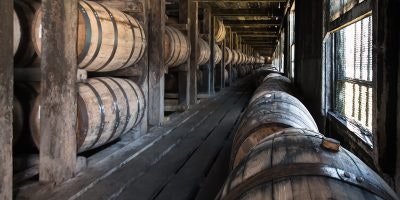American oak rules the world of spirits. Bourbon must be aged in it—new, charred American oak, to be specific—and therefore it dictates much of the flavor profile in American whiskey. Those instantly relegated used casks then live second lives as the workhorses of the scotch and rum worlds. But all across the globe, creative producers are turning elsewhere, and using different types of wood in different ways. In doing so, these spirits offer up a spectrum of unique mash-ups and flavors to sample.
Citadelle’s Wooden Egg
Alexandre Gabriel went full-on mad scientist for the newest release of Citadelle Gin Reserve. First he rests gin in five different wooden casks—acacia, mulberry, cherry, chestnut and French oak—for five months. Using those unique woods wasn’t creative enough, apparently. Those five separate gins are then blended together in a massive, eight foot tall, egg-shaped oak cask. As a result, the flavors marry to produce a cohesive and entirely unique spirit.
Citadelle’s Wooden Egg / Photo Credit: Citadelle
Nelson’s Green Brier Craftsman Cask Collection
Building on the wild success of their Belle Meade Bourbon line, including finishes in sherry, cognac, and madeira, brothers Andy and Charlie Nelson unveiled the Craftsman Cask Collection. The year-long series will include four separate releases, starting with spring’s Mourvèdre Cask, and summer’s Honey Cask.
Belle Meade Bourbon Honey Cask / Photo Credit: Nelson’s Green Brier
For the former, they partnered with Withers Winery to snag a cask from a unique wine variety which is not often put to use with spirits aging. For the latter, they turned to Tennessee’s TruBee Honey, using two casks which previously held natural honey from the artisan producer. The next two releases haven’t been unveiled as of this time.
Scotch Whisky Meets American Rye
Glenmorangie’s Dr. Bill Lumsden is known as one of the masterminds of wine-cask finishing. For Spìos, the 9th release in the Glenmorangie Private Edition series, he went in a different direction. He fully matured the whisky in used American rye whiskey casks. While rye whiskey’s growth has been raging as of late, Lumsden had enough foresight to start this project well ahead of the trend, as it was ready for release at the start of 2018.
Glenmorangie Spìos / Photo Credit: Glenmorangie
VIRGINIAN HICKORY SYRUP
Catoctin Creek just unveiled a limited edition of its Roundstone Rye. They finished the whiskey in a hickory syrup barrel from Falling Bark Farm, and bottled it at a cask strength near 60% ABV. It’s actually the second time the brand has done such a release. With a single cask used at a time, the bottles go quickly.
Roundstone Rye Cask Proof Hickory Finish / Photo Credit: Catoctin Creek
Mizunara Reaches New Shores
Prized Mizunara oak has been one of the secret weapons of Japanese whisky, particularly in Suntory’s usage of it. Now though, Mizunara has been turning up on distant shores. In Ireland, Glendalough uses this Japanese oak to finish its 13-year-old single malt.
Glendalough 13 Year Mizunara Finish / Photo Credit: Glendalough
In the States, Bainbridge Distillery uses Mizunara for its highly acclaimed Yama Whiskey. Incidentally, Yama is named for the town on Bainbridge Island, founded by Japanese immigrants, and not as a nod to Yamazaki. Upon the Yama’s release in 2016, it was said to be the first non-Japanese whiskey aged entirely in Mizunara.
Why Not Cider?
Beer barrels have long been used to fully mature, or finish, whiskey. So, why not cider, thought Virginia Distillery Company. The brand’s Cider Cask Finished Virginia Highland Whisky spends between 8 to 12 months in cider casks from various producers—including Potter’s Craft Cider—offering a range of apple and orchard fruit flavors. In Ireland, Tullamore D.E.W. puts cider casks to use to finish a blended whiskey first matured in bourbon and sherry casks.
Tullamore D.E.W. Cider Cask / Photo Credit: Tullamore D.E.W.
Brazilian Indigenous Woods
Of course, any discussion on unique woods and barrel-aging must include cachaça. A full spectrum of indigenous woods from Brazil are employed to mature its native spirit. Peter Nevenglosky, co-founder of Avuá Cachaça, told me in a recent discussion that they are using no less than 30 different woods.
Avuá Cachaça / Photo Credit: Avuá Cachaça
Avuá has used Amburana, Jequitibá Rosa, Tapinhoã, and in an upcoming summer 2018 release, Bálsamo. Each offers wildly different flavors, from the cinnamon and clove-laden Amburana, to the delicate fruits of Jequitibá, and the herbaceous minerality of Bálsamo. Meanwhile, Novo Fogo also has a penchant for using a range of wood varieties, such as zebrawood for its Tanager release, and para, or Brazil nut, for Graciosa.
Clearly there’s more to barrel-aging than American and French oak, or bourbon and sherry casks.
With Distiller, you’ll always know what’s in the bottle before you spend a cent. Rate, Review and Discover spirits! Head on over to Distiller, or download the app for iOS and Android today!


